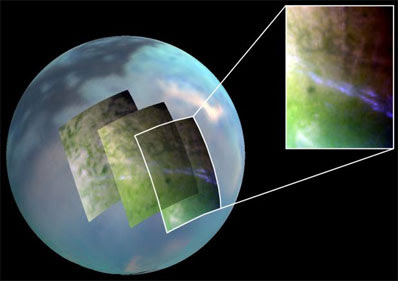Astronomy

- Titan May Have Subsurface Ocean Of Hydrocarbons
Saturn's largest moon, Titan, may have a subterranean ocean of hydrocarbons and some topsy-turvy topography in which the summits of its mountains lie lower than its average surface elevation, according to new research. Titan is also more squashed...
- "mission Accomplished, But New Questions Await!"
That's what NASA is announcing about their Cassini mission. Today, on June 30, Cassini is ending its primary mission, lasting for four years. But Cassini is not done with Saturn and its moons. There is still much too left to learn about Saturn, and...
- Triple Crescent Moons Of Saturn.
A single crescent moon is a familiar sight in Earth's sky, but with Saturn's many moons, we can see three or even more. The three moons shown here, Titan [5,150 kilometers across], Mimas [396 kilometers across] and Rhea [1,527 kilometers across]...
- A Formation Of Noctilucent Clouds.
Noctilucent clouds or Night clouds are made of crystals of water ice. They are the highest clouds in Earth's atmosphere, located in the mesosphere at altitudes of around 76 to 85 kilometres. Noctilucent clouds are normally too faint to be seen and...
- Nasa Wants To Send A Nuclear Submarine To Saturn's Moon Titan
NASA is planning to send a nuclear-powered submarine to explore one of the methane seas located on Saturn's moon Titan.The concept robot submarine is equipped with a seafloor camera and sampling system. The submarine could fit into a space plane...
Astronomy
Cassini finds Titan's clouds hang on to summer

Cloud chasers studying Saturn's moon Titan say its clouds form and move much like those on Earth, but in a much slower, more lingering fashion.
Their forecast for Titan's early autumn -- warm and wetter.
Scientists with NASA's Cassini mission have monitored Titan's atmosphere for three-and-a-half years, between July 2004 and December 2007, and observed more than 200 clouds. They found that the way these clouds are distributed around Titan matches scientists' global circulation models. The only exception is timing -- clouds are still noticeable in the southern hemisphere while fall is approaching.
As summer changes to fall at the equinox in August 2009, Titan's clouds are expected to disappear altogether. But, circulation models of Titan's weather and climate predict that clouds at the southern latitudes don't wait for the equinox and should have already faded out since 2005. However, Cassini was still able to see clouds at these places late in 2007, and some of them are particularly active at mid-latitudes and the equator.
Titan is the only moon in our solar system with a substantial atmosphere, and its climate shares Earth-like characteristics. Titan's dense, nitrogen-methane atmosphere responds much more slowly than Earth's atmosphere, as it receives about 100 times less sunlight because it is 10 times farther from the sun. Seasons on Titan last more than seven Earth years.
Scientists will continue to observe the long-term changes during Cassini's extended mission, which runs until the fall of 2010. Cassini is set to fly by Titan on June 6.
- Titan May Have Subsurface Ocean Of Hydrocarbons
Saturn's largest moon, Titan, may have a subterranean ocean of hydrocarbons and some topsy-turvy topography in which the summits of its mountains lie lower than its average surface elevation, according to new research. Titan is also more squashed...
- "mission Accomplished, But New Questions Await!"
That's what NASA is announcing about their Cassini mission. Today, on June 30, Cassini is ending its primary mission, lasting for four years. But Cassini is not done with Saturn and its moons. There is still much too left to learn about Saturn, and...
- Triple Crescent Moons Of Saturn.
A single crescent moon is a familiar sight in Earth's sky, but with Saturn's many moons, we can see three or even more. The three moons shown here, Titan [5,150 kilometers across], Mimas [396 kilometers across] and Rhea [1,527 kilometers across]...
- A Formation Of Noctilucent Clouds.
Noctilucent clouds or Night clouds are made of crystals of water ice. They are the highest clouds in Earth's atmosphere, located in the mesosphere at altitudes of around 76 to 85 kilometres. Noctilucent clouds are normally too faint to be seen and...
- Nasa Wants To Send A Nuclear Submarine To Saturn's Moon Titan
NASA is planning to send a nuclear-powered submarine to explore one of the methane seas located on Saturn's moon Titan.The concept robot submarine is equipped with a seafloor camera and sampling system. The submarine could fit into a space plane...
